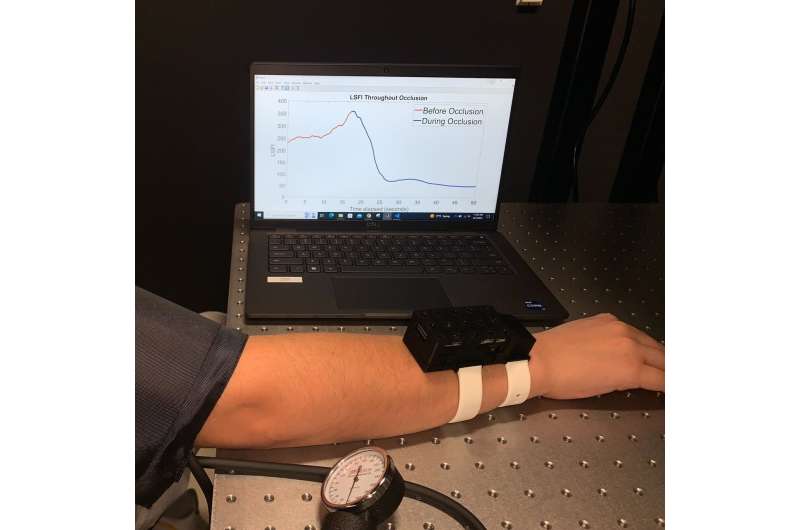This article has been reviewed according to Science X's editorial process and policies. Editors have highlighted the following attributes while ensuring the content's credibility:
fact-checked
peer-reviewed publication
trusted source
proofread
Wearable optical device shows promise for detecting postpartum hemorrhage

Researchers have developed a wearable optical device for early detection of hemorrhage during labor or after childbirth. This serious heavy bleeding can be hard to detect before it becomes an emergency and accounts for almost 30% of maternal deaths globally and just over 10% of maternal deaths in the United States.
Studies have shown that early diagnosis and treatment for postpartum hemorrhage is the best way to prevent deaths. The new device is designed to be worn on the wrist, where it uses laser speckle imaging to continuously monitor for a decrease in blood flow that provides an early indication that heavy bleeding is taking place elsewhere in the body.
"Postpartum hemorrhage most severely impacts people in low- and middle-income areas, who have limited access to high-quality medical diagnostics and treatments," said the research team leader Christine O'Brien from Washington University in St. Louis. "We were inspired to develop an accessible tool that can be used in both low- and high-resource settings to detect this condition earlier than current methods. This work is the first step in the development and proof-of-concept testing of our initial prototype."
In the journal Biomedical Optics Express, the researchers describe studies that validated the prototype's ability to detect changes in blood flow using a swine model of hemorrhage. Based on these positive results, they are now conducting studies with healthy volunteers.
"Our hope is that this work will lead to a device that will enable prevention of morbidity and mortality caused by postpartum hemorrhage, ensuring new moms make it home safely with their babies," said the paper's first author Francesca Bonetta-Misteli. "In a medical setting, it could be useful for monitoring how patients are responding to treatment for a hemorrhage. It could also offer a standalone tool for use at home or in other settings that alerts mothers giving birth when they may be in danger and should seek medical attention."
Catching early signs
During a hemorrhage, the body initiates a process called peripheral vasoconstriction to redirect blood flow to the vital organs by restricting blood to peripheral body parts that are less essential like hands, feet and arms. This causes a decrease in blood flow in the peripheral locations while blood flow remains normal in the body core.
"Because of peripheral vasoconstriction, vital signs can remain unchanged until there is very severe blood loss, meaning that in many instances we cannot use vital signs to detect postpartum hemorrhage before it becomes severe," said O'Brien. "By monitoring blood flow in the wrist, our device can detect peripheral vasoconstriction as it occurs in response to postpartum hemorrhage before the patient starts to show symptoms."
A multidisciplinary team, including engineers and physicians, developed the wearable device, which uses laser speckle flow index (LSFI) to detect hemorrhage-induced peripheral vasoconstriction. LSFI extracts information about blood flow by using a laser and a camera to detect and quantify spatial and temporal changes in speckle patterns that are formed when the light interacts with flowing blood cells.
Although wearable laser speckle imaging sensors have been developed for real-time monitoring of blood flow and cardiovascular physiology, the researchers had to create a wireless, battery-powered laser speckle system that could be worn on the wrist. They also developed a fast speckle processing protocol for onboard video data processing.
Testing sensitivity to blood flow changes
To test the device, the researchers placed it on a tissue-mimicking phantom with a hollow channel, through which they flowed a milk-like liquid to simulate blood flow. When they altered the rate at which the liquid flowed over a range that would be expected in blood vessels, the researchers observed a nearly perfect linear response to the flow rate. This indicated that the device was highly sensitive to blood flow at the expected physiological conditions.
They then conducted a hemorrhage and resuscitation study in a swine animal model. As test animals lost blood, the device detected near-immediate, continuous decreases in blood flow. The response was almost perfectly linear, with an average correlation between detected blood flow measure and volume of blood removed of 0.94.
Additionally, in most animals, the device measured an increase in blood flow during intravenous injection with saline, indicating that the added volume helped increase blood flow to the periphery. This indicates that the wearable laser speckle imaging sensor could be used to monitor patients for early signs of postpartum hemorrhage and track their response to resuscitation efforts.
The researchers are now creating new prototypes that use a more stable, smaller laser with lower laser power and a longer battery life and that could provide faster results. In addition to testing the device with healthy volunteers, they plan to begin enrolling pregnant women in a clinical study at Washington University in the coming months. They also hope to partner with investigators from countries with high mortality rates due to postpartum hemorrhage to test the device's performance and utility in resource-limited settings.
"To move beyond research application to true clinical use, the device would need to be manufactured by a commercial partner that can create a device that meets regulatory criteria, and this device would need to undergo testing under a number of conditions and with a diverse population. It will also be critical to obtain feedback from patients, nurses, physicians and other members of the health care team throughout the development process." said O'Brien.
"We are obtaining feedback and conducting many of these tests with our research prototypes, including the consideration of artifacts caused by motion and testing performance across a range of skin pigmentation levels to ensure the results are not biased by skin color."
More information: Francesca Bonetta-Misteli et al, Development and evaluation of a wearable peripheral vascular compensation sensor in a swine model of hemorrhage, Biomedical Optics Express (2023). DOI: 10.1364/BOE.494720



















